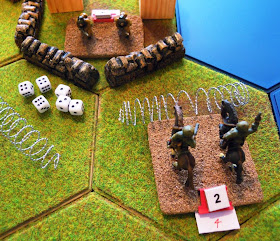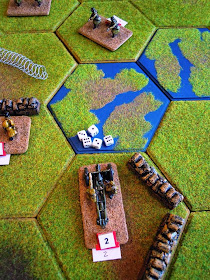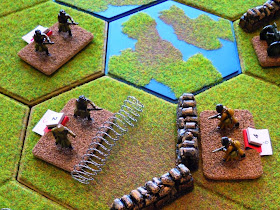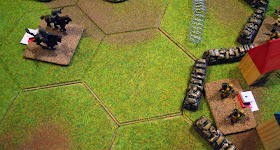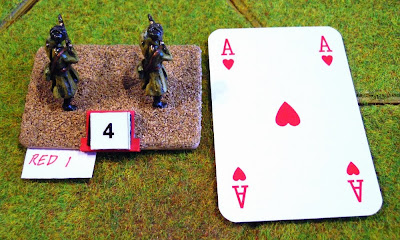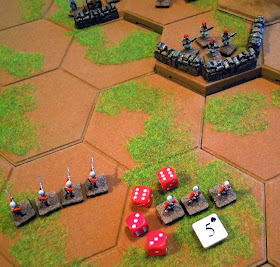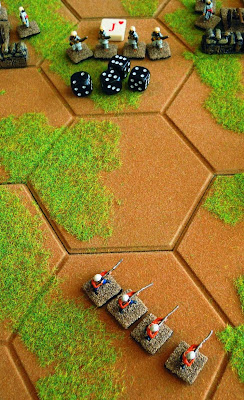I set up this small battle in order to play-test the latest draft of my Itchy and Scratchy rules. Because it was played solo I used an alternative move sequence that relied upon playing card tiles to activate each side's units.
The turn sequence was as follows:
- At the start of each turn a small playing card or playing card tile is deal or picked out of the bag and placed FACE DOWN next to each unit and General on the tabletop.
- Once each unit and General has been allocated a small playing card or playing card tile, the small playing cards or playing card tiles are turned over and units and Generals are activated in turn. The order of activation is in ascending numerical/face value and suit order precedence (i.e. Ace, 2, 3, 4, 5, 6, 7, 8, 9, 10, Jack, Queen, and King being the numerical/face values, and Hearts, Clubs, Diamonds, and Spades the suit order precedence).
- Once both sides have moved and/or conducted combats with each of their units and Generals in turn – subject to any restrictions laid down in the rules – the turn is complete.
- Once both sides have moved and/or conducted combats with each of their units and Generals in turn they must check to see if they have reached their Exhaustion Point. Once that has been done, the turn is complete and the next turn can commence.
This play-test also gave me the opportunity to experiment with an idea that I had, and that was:
- To allow a General to activate a unit they were co-located with when it was the General's turn to be activated and
- To allow the unit the General was co-located with the be activated when it was the unit's turn to be activated.
By doing this it was possible for a unit to be activated twice during a game turn
and gave a command role (rather than just a supporting role) to the General.
Background
Gaziri tribes, led by Mohamed Bashir Khan, have been raiding into Chindia again. The local army commander – Sir Hector Boleyn-Green – was given the task of preventing further raids, and as an old frontier hand he knew that the only way to do that was to mount a punitive expedition into Gaziristan. He could then disperse Mohamed Bashir Khan's supporters and destroy his base.
Mohamed Bashir Khan had based himself just inside the Gaziristan border. He had taken over and rebuilt an ancient stone tower in a valley which he thought he could defend with ease. His supporters had built a number of sangars atop the hills at the entrance to the valley and further sangars on the valley floor. Mohamed Bashir Khan knew that these defences would be difficult to break through and that any attackers should suffer serious casualties.
The forces he had available to deploy in the valley's defences were not insignificant, and include six warbands of tribesmen and two batteries of smooth-bore cannon
Sir Hector Boleyn-Green had been given a small Infantry Brigade (part of the Gaziri Frontier Field Force) with which to mount his punitive expedition. The brigade included:
- 1st Battalion, MacBean Highlanders
- 2nd Battalion, Royal Surrey Regiment
- 3rd Battalion, Frontier Guides
- Gatling Gun Detachment, Yorkshire Fusiliers
- X Battery, Royal Artillery
Turn 1
The playing card tiles were picked out of their bag, placed face down next to each unit and General, and then turned over.
The units and Generals were then activated in turn.
One of the Gaziri Red Turban warbands opened fire on the MacBean Highlanders at maximum range ... and hit them!
This was followed by one of the Gaziri artillery batteries firing at the Frontier Guides ... to no avail.
The next unit to be activated (a Gaziri Cream Turban warband) remained where it was and did not fire.
The other Gaziri artillery battery then fired at the MacBean Highlanders, but their fire was inaccurate.
It was now the turn of the Frontier Guides, who moved forward and fired at the Gaziri Cream Turban warband in the nearby sangar. Their fire was on target but caused no casualties.
The next unit to be activated (a Gaziri White Turban warband) remained where it was and did not fire.
In the centre the Royal Surreys advanced but did not fire.
On the right flank the MacBean Highlanders advanced and fired at the Gaziri Red Turban warband in the nearby sangar ... and inflicted a casualty!
The next unit to be activated (a Gaziri Red Turban warband) remained where it was and did not fire.
X Battery, Royal Artillery moved out towards the left flank of the advance so that it could fire on the nearby sangar next turn.
The Gaziri Cream Turban warband in the sangar fired at the oncoming Frontier Guides, but inflicted no casualties.
At this point Sir Hector Boleyn-Green moved forward ...
... followed by the Gatling Gun Detachment, Yorkshire Fusiliers.
Mohamed Bashir Khan also moved forward to join one of the Gaziri artillery batteries.
The final unit to be activated (a Gaziri White Turban warband) remained where it was and did not fire.
Turn 2
The playing card tiles were picked out of their bag, placed face down next to each unit and General, and then turned over.
X Battery, Royal Artillery engaged the nearest sangar, and thanks to some superb shooting they inflicted a casualty on the Gaziri Cream Turban warband in the sangar.
The next unit to be activated (a Gaziri Red Turban warband) remained where it was and did not fire.
The Royal Surreys then opened fire on the Gaziri Red Turban warband, but their rifle fire was ineffective.
The next unit to be activated (a Gaziri Cream Turban warband) remained where it was and did not fire.
The Gatling Gun Detachment, Yorkshire Fusiliers then fired at the same Gaziri Red Turban warband. Their machine gun fire was much more effective than the Royal Surrey's rifle fire and caused a casualty.
Sir Hector Boleyn-Green, who was co-located with the Gatling Gun Detachment, Yorkshire Fusiliers, encouraged them to fire again ... which they did, inflicting a further casualty on the Gaziri Red Turban warband.
Not to be outdone by his opponent Mohamed Bashir Khan exhorted the Gaziri artillery battery with which he was co-located to open fire on the MacBean Highlanders ... but their fire was inaccurate and they missed their target.
It was now the turn of the Frontier Guides to engage the Gaziri Cream Turban warband in the nearby sangar ... and despite being under cover the Gaziris suffered a casualty.
At this point the MacBean Highlanders moved forward and engaged the remnants of the Gaziri Red Turban warband that was occupying the sangar. The Gaziris fought back, but the Highlanders prevailed and destroyed the Gaziri warband.
One of Gaziri artillery batteries opened fire on the Frontier Guides ... and missed.
One of the Gaziri White Turban warbands moved out of its defensive position and fired at the Royal Surreys ... but their rifle fire was ineffective and caused no casualties.
At that point the Gaziri Cream Turban warband in the sangar fired at the Frontier Guides without effect.
The next unit to be activated (a Gaziri White Turban warband) remained where it was and did not fire.
The Gaziri artillery battery that was co-located with Mohamed Bashir Khan fired at the MacBean Highlanders in the hope that they could inflict further casualties on them ... but despite the short range the artillery fire was inaccurate.
Turn 3
The playing card tiles were picked out of their bag, placed face down next to each unit and General, and then turned over.
One of the Gaziri White Turban warbands charged forward and engaged the Royal Surreys in close combat, causing one casualty and forcing them to withdraw.
The Royal Surreys replied with a volley of rifle fire which caused a casualty on the Gaziri White Turban warband.
The Gaziri artillery battery that was co-located with Mohamed Bashir Khan fired yet again at the MacBean Highlanders ... and caused them a single casualty.
X Battery, Royal Artillery fire at the nearby sangar that was occupied by a Gaziri Cream Turban warband but was unable to hit their target.
The remaining Gaziri Red Turban warband rushed forward to reoccupy the sangar and this brought them into close combat with the MacBean Highlanders. Both sides inflicted casualties on the other, but the MacBean Highlanders were forced to fall back.
The second Gaziri artillery battery fired at the Frontier Guides and inflicted a casualty upon them.
Despite this set-back the Frontier Guides were still able to fire at the Gaziri White Turban warband that had earlier engaged the Royal Surreys, but their rifle fire was ineffective.
As it appeared that the battle was beginning to go their way, the Gaziri White Turban warband that had been positioned behind Mohamed Bashir Khan moved forward and onto the lower, passable slopes of the mountain.
The Gaziri Cream Turban warband in the sangar fired at the Frontier Guides ... and reduced their numbers even further.
The remaining MacBean Highlander fired at the nearby Gaziri White Turban warband, and caused them to suffer a casualty.
The Gatling Gun Detachment, Yorkshire Fusiliers that was co-located with Sir Hector Boleyn-Green fired at the Gaziri Red Turban warband in the sangar ... and inflicted a casualty upon them.
The Gaziri artillery battery with which Mohamed Bashir Khan was co-located fired for a third time at the MacBean Highlanders ... and wiped them out!
With the urging of Sir Hector Boleyn-Green, the Gatling Gun detachment, Yorkshire Fusilier fired yet again at the Gaziri Red Turban warband in the sangar ... and inflicted yet another casualty.
Seeing an opportunity to deal the Frontier Guides a mortal blow, the Gaziri Cream Turban warband that had been on the lower slopes of the mountain charged forward ... and wiped out the Frontier Guides!
At this point Sir Hector Boleyn-Green realised that his troops were exhausted and stood no chance of winning the battle despite the fact that they had inflicted far more casualties than they had suffered. He therefore decided to withdraw in order to regroup and bring up reinforcements.
Mohamed Bashir Khan realised how close he had come to defeat, but the sight of his enemy retreating gave him and his surviving troops good reason to rejoice. A feast would be held to celebrate this victory over the accursed infidels ... but after that Mohamed Bashir Khan knew that he would have to prepare for further battles against his sworn enemy. He may have won today, but only Allah knew who would win tomorrow.
Conclusions
I fought this battle on and off over the space of three days, and the playing card tiles made it very easy to see which units had been activated and which had not.
The playing card tiles also made it easier to fight the battle solo as each activation was – in effect – a separate sub-turn. I looked at the tactical situation as a unit was activated and decided what its best course of action was
at that particular moment.
The rule that allowed Generals to activate a unit that they were co-located with when it was the General's turn to be activated worked well, and I intend to incorporate it in the next draft of the rules.


















